The Intel 9th Gen Review: Core i9-9900K, Core i7-9700K and Core i5-9600K Tested
by Ian Cutress on October 19, 2018 9:00 AM EST- Posted in
- CPUs
- Intel
- Coffee Lake
- 14++
- Core 9th Gen
- Core-S
- i9-9900K
- i7-9700K
- i5-9600K
Gaming: Ashes Classic (DX12)
Seen as the holy child of DirectX12, Ashes of the Singularity (AoTS, or just Ashes) has been the first title to actively go explore as many of the DirectX12 features as it possibly can. Stardock, the developer behind the Nitrous engine which powers the game, has ensured that the real-time strategy title takes advantage of multiple cores and multiple graphics cards, in as many configurations as possible.
As a real-time strategy title, Ashes is all about responsiveness during both wide open shots but also concentrated battles. With DirectX12 at the helm, the ability to implement more draw calls per second allows the engine to work with substantial unit depth and effects that other RTS titles had to rely on combined draw calls to achieve, making some combined unit structures ultimately very rigid.
Stardock clearly understand the importance of an in-game benchmark, ensuring that such a tool was available and capable from day one, especially with all the additional DX12 features used and being able to characterize how they affected the title for the developer was important. The in-game benchmark performs a four minute fixed seed battle environment with a variety of shots, and outputs a vast amount of data to analyze.
For our benchmark, we run Ashes Classic: an older version of the game before the Escalation update. The reason for this is that this is easier to automate, without a splash screen, but still has a strong visual fidelity to test.
| AnandTech CPU Gaming 2019 Game List | ||||||||
| Game | Genre | Release Date | API | IGP | Low | Med | High | |
| Ashes: Classic | RTS | Mar 2016 |
DX12 | 720p Standard |
1080p Standard |
1440p Standard |
4K Standard |
|
Ashes has dropdown options for MSAA, Light Quality, Object Quality, Shading Samples, Shadow Quality, Textures, and separate options for the terrain. There are several presents, from Very Low to Extreme: we run our benchmarks at the above settings, and take the frame-time output for our average and percentile numbers.
All of our benchmark results can also be found in our benchmark engine, Bench.
| Ashes Classic | IGP | Low | Medium | High |
| Average FPS | 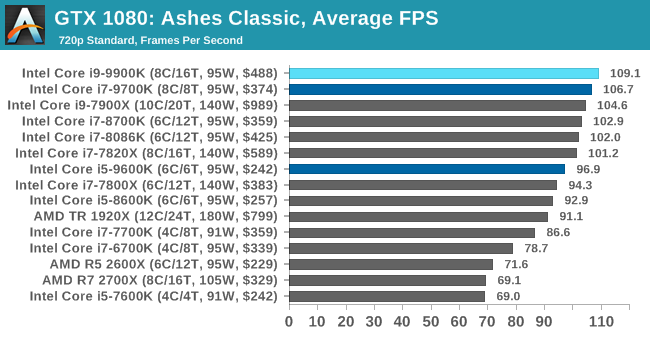 |
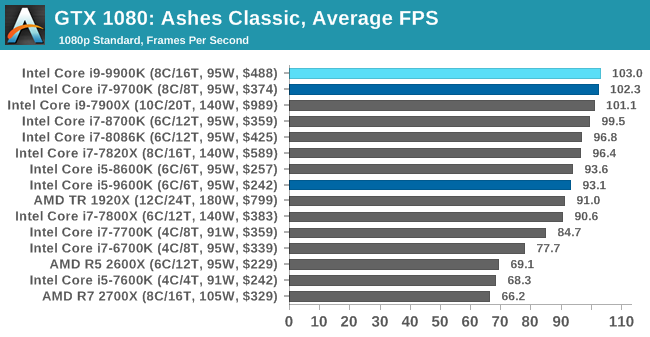 |
 |
 |
| 95th Percentile | 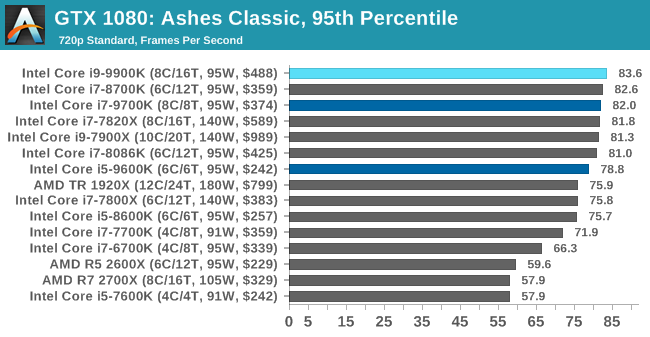 |
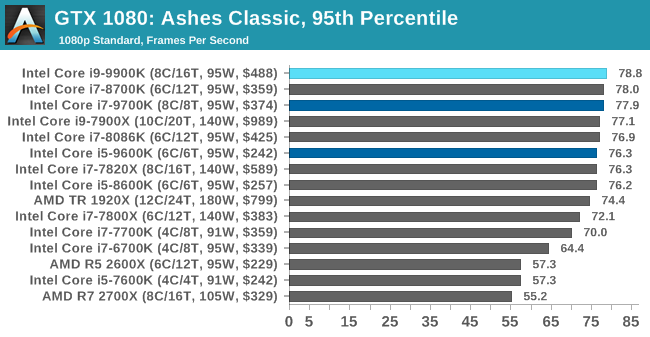 |
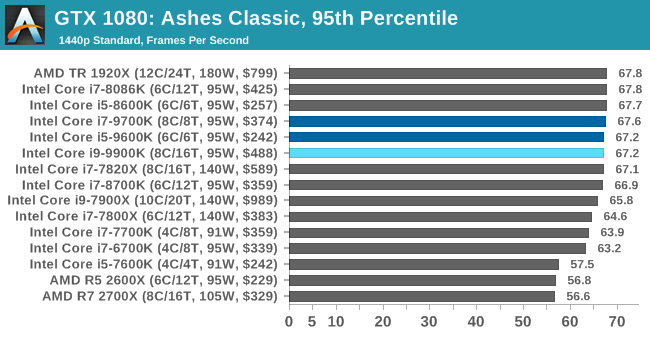 |
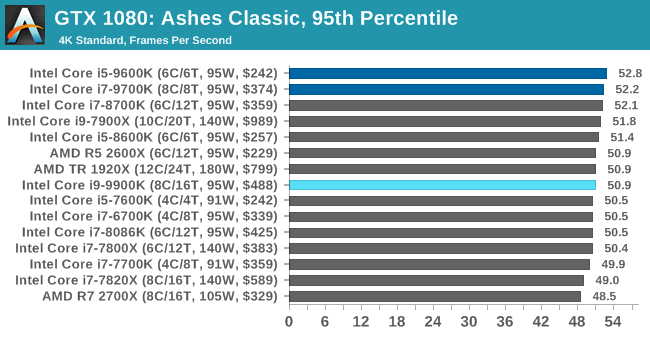 |
As a game that was designed from the get-go to punish CPUs and showcase the benefits of DirectX 12-style APIs, Ashes is one of our more CPU-sensitive tests. Above 1080p results still start running together due to GPU limits, but at or below that, we get some useful separation. In which case what we see is that the 9900K ekes out a small advantage, putting it in the lead and with the 9700K right behind it.
Notably, the game doesn’t scale much from 1080p down to 720p. Which leads me to suspect that we’re looking at a relatively pure CPU bottleneck, a rarity in modern games. In which case it’s both good and bad for Intel’s latest CPU; it’s definitely the fastest thing here, but it doesn’t do much to separate itself from the likes of the 8700K, holding just a 4% advantage at 1080p. This being despite its frequency and core count advantage. So assuming this is not in fact a GPU limit, then it means we may be encroaching on another bottleneck (memory bandwidth?), or maybe the practical frequency gains on the 9900K just aren’t all that much here.
But if nothing else, the 9900K and even the 9700K do make a case for themselves here versus the 9600K. Whether it’s the core or the clockspeeds, there’s a 10% advantage for the faster processors at 1080p.












274 Comments
View All Comments
0ldman79 - Friday, October 19, 2018 - link
AMD needs to improve their AVX processing as well, but they've got Intel in a bit of a predicament.Hifihedgehog - Friday, October 19, 2018 - link
Ladies and gentlemen, I present to you...Intel’s FX 9000 series.
Now even hotter and more power hungry than ever!
mapesdhs - Sunday, October 21, 2018 - link
It reminds me a lot of the P4 days when Intel just had to shove clocks through the roof to remain relevant. And I don't know why tech sites are salivating so much on oc levels that are barely any better than a chip's max turbo, it's a far cry from the days of SB, especially since one can run a 2700K at 5GHz with sensible voltage and good temps using a simple air cooler (ordinary TRUE works fine) and one fan, without high noise (I know, I've built seven of them so far). To me, the oc'ing potential of the 9K series is just boring, especially since the cost is so high that for gaming one is far better off buying a 2700X, 8700K (or many other options) and using the save to get a better GPU.sgeocla - Friday, October 19, 2018 - link
Why compare to the TR 1920x ($799) and not to the TR 2950X ($899)?The TR 2950X kills it in almost every productivity benchmark even against i-9 9900k.
Not even mentioning the 9th gen power consumption.
Yorgos - Friday, October 19, 2018 - link
don't bother with the review.They show you the results that makes intel seem good.
Intel/Purch media have failed to show to the people that they exceed even Threadripper's TDP in order to fight Zen.
Desperate moves for desperate times.
Better look somewhere else for an unbiased review.
mkaibear - Friday, October 19, 2018 - link
What, you mean apart from page 21 where it shows that it almost doubles Threadripper's TDP for the same core count CPU and is 50% greater than the one which has 50% more cores than it does?Some reading comprehension lessons needed I think.
yeeeeman - Friday, October 19, 2018 - link
The 9900K looks like a nice CPU, but damn that power consumption is stupidly high. It is almost twice what the 2700X consumes.Hifihedgehog - Friday, October 19, 2018 - link
*High-end AIO required.AGS3 - Friday, October 19, 2018 - link
Twice the CPU - 8 cores over 5Ghz :)AutomaticTaco - Saturday, October 20, 2018 - link
Revised down. The first motherboard they used was extremely higher voltage settings.https://www.anandtech.com/show/13400/intel-9th-gen...